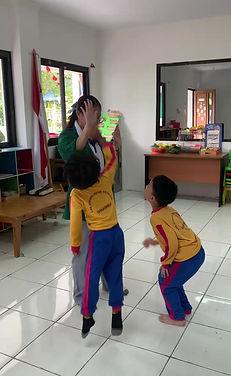
Bridging Cultures: My Practicum Experience in Indonesia as a Filipino Student
My Teaching Experience in Lab School
Paud Permata Uhamka
Welcoming Ceremony

Klepon Making

A Sweet Start: Learning to Make Klepon in Indonesia
One of the highlights of my first week as a SEA Teacher was experiencing Indonesian culture through food. After class, I was invited to join a local teacher in making Klepon—a traditional Indonesian sweet treat. These green, chewy rice balls are filled with melted palm sugar and coated in freshly grated coconut.
The process was simple yet meaningful. I learned how to shape the dough, add the palm sugar center, and cook the balls until they floated—signaling they were done. The best part? Rolling them in coconut and sharing laughs with the teachers while we cooked.
It was a beautiful way to connect, learn, and taste a piece of Indonesian tradition. Moments like this remind me that cultural exchange isn't just about observing—it's about participating and creating memories together.
Filipino Values


Sharing Filipino Values with Indonesian Pre-Schoolers
As part of my SEA Teacher journey, I had the special opportunity to teach Filipino values to the adorable pre-school students at Lab School Paud Permata UHAMKA in Indonesia. It was a heartwarming experience to introduce them to some of our most cherished traditions—simple yet meaningful acts that show respect and humility in Filipino culture.
I taught them how we use “po” and “opo” when speaking to elders as a sign of respect. We also practiced “pagmamano”, where we gently take an elder’s hand and place it on our forehead. The students were especially excited about this gesture and even tried it with their teachers! Lastly, I shared the Filipino custom of doing a small bow when greeting or showing gratitude.
Even at such a young age, the children were very responsive and eager to learn. It was beautiful to see how respect is a universal value that connects our cultures. Moments like these remind me that teaching goes beyond academics—it’s about sharing our hearts and traditions, too.
Basic Filipino Greetings

Bridging Cultures Through Language: Teaching Basic Filipino Greetings
During my SEA Teacher experience, one of the most exciting parts of my teaching journey was introducing Basic Filipino Greetings to my Indonesian students. It was a fun and meaningful way to share a piece of my culture while also helping them appreciate the similarities and differences between our languages.
I taught them how to say “Magandang Umaga” (Good Morning), “Magandang Tanghali” (Good Noon), “Magandang Gabi” (Good Evening), and “Kumusta Ka?” (How are you?). To help them understand better, I translated each greeting into Bahasa Indonesia:
-
Magandang Umaga – Selamat Pagi
-
Magandang Tanghali – Selamat Siang
-
Magandang Gabi – Selamat Malam
-
Kumusta Ka? – Apa Kabar?
The students were eager to learn and had fun repeating the words, trying their best to pronounce each one correctly. It was heartwarming to hear them greet me in Filipino the next day, proudly saying, “Magandang Umaga, Miss Kath!”
Filipino Traditional Game

Bringing Fun and Culture Together: Teaching Tumbang Preso to Indonesian Students
As part of my SEA Teacher journey, I wanted to share not just the language and values of the Philippines, but also the joy of our childhood games. One of the most exciting moments was when I introduced a traditional Filipino game called Tumbang Preso to my Indonesian students.
Tumbang Preso is a classic Filipino street game that many of us grew up playing. It’s simple, active, and loads of fun! For the game, we used just a few materials: an empty can (to act as the target) and some slippers or sandals for throwing. The mechanics are easy to follow—one player guards the can (the "preso") while the others try to knock it down using their slippers and quickly retrieve them before getting tagged.
Before playing, I explained the rules and translated some of the instructions into Bahasa Indonesia to make sure everyone understood. Once we started, the energy was amazing! The students were laughing, running, and cheering each other on. Even though it was their first time playing, they picked it up quickly and gave it their all.
What touched me the most was how much they enjoyed it. In the following days, many of them came up to me, asking, “Teacher, play Tumbang Preso again?” It warmed my heart to see them so excited about a game that brought me joy as a child—and now, was doing the same for them.